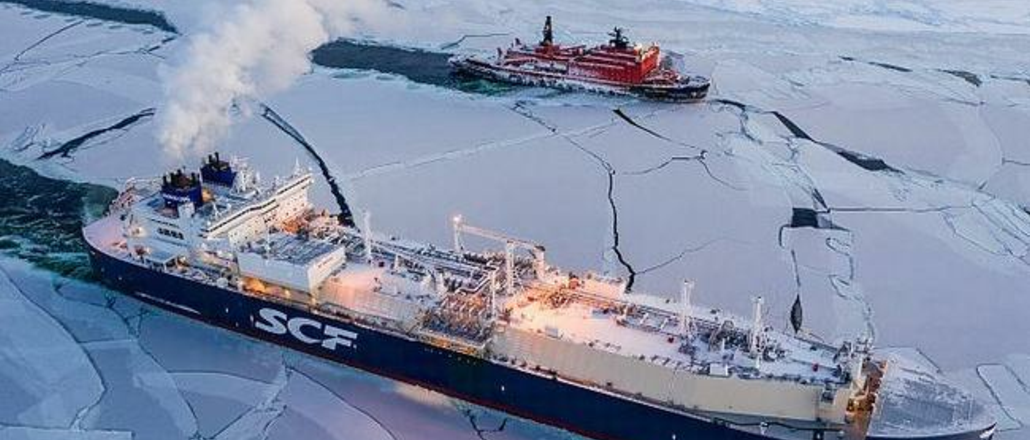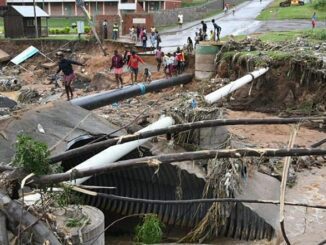
ST. PETERSBURG, Russia, February 22, 2021 (ENS) – The Arctic’s icy Northern Sea Route is melting, allowing the Russian icebreaking LNG carrier Christophe de Margerie to complete her experimental round trip voyage across the Arctic in winter. For the first time in history, due to climate warming, the Arctic ice has thawed enough to allow a large-capacity cargo vessel to transit the eastern portion of the Northern Sea Route, NSR, in January.
Normally, transit navigation along this segment of the Northern Sea Route ends in November and only resumes in July.
The Christophe de Margerie began her journey on January 5, 2021, at the port of Sabetta on Russia’s northern coast heading for the province of Jiangsu on China’s east-central coast. The LNG carrier safely completed her passage eastward along the Northern Sea Route in 11 days, navigating the length of the NSR without icebreaker assistance.

After discharging her cargo at the Port of Jiangsu on January 27, the LNG tanker sailed back towards Sabetta, and on February 7, upon reaching the eastern end of the Northern Sea Route, Cape Dezhnev, met the icebreaker 50 Let Pobedy, which escorted her back to Sabetta. She sailed into the port of Sabetta on February 19.
Yury Trutnev, Russia’s Deputy Prime Minister and Presidential Envoy to the Far Eastern Federal District held a meeting Thursday on the Christophe de Margerie’s experimental eastbound voyage along the Northern Sea Route during the autumn-winter navigation season.
“The Northern Sea Route can and must become Russia’s most important transport artery, cutting the sea route from Europe to Asia by more than a third,” Trutnev said, opening the meeting. “In 2020, almost 33 million tons of cargo were transported along the Northern Sea Route, including more than 18 million tons of liquefied natural gas. Over the past five years, freight traffic has increased almost fivefold. But the potential of the Northern Sea Route is much greater.”
Trutnev said that in accordance with the decree of Russian President Vladimir Putin, “the traffic along the Northern Sea Route must increase to 80 million tons a year by 2024. This task can be achieved by increasing the period of Arctic navigation.”
“A significant contribution to the further development of year-round navigation along the Northern Sea Route will be made by the commissioning of 15 new-generation icebreaking LNG carriers currently under construction at Russia’s Zvezda shipyard for our new project, Arctic LNG 2,” Trutnev said.
From 2023 to 2025, the company plans to take delivery of 18 new-generation icebreaking LNG carriers to service the Arctic LNG 2 project, which will create over a thousand new jobs for Russian seafarers.
In 2020, Sovcomflot initiated a large-scale program to train the required personnel from its existing officers and Trutnev said the company will make greater effort to train these professionals “within the Russian system of maritime vocational training.”
“In addition, we expect that two new nuclear-powered icebreakers of the LC-60 type will be commissioned by the end of 2022. This will enable us and our partner Atomflot to ensure year-round transportation of LNG along the eastern sector of the Northern Sea Route from the Arctic LNG 2 project, whose first processing line is scheduled to be launched in early 2023,” he said.

Atomflot is a Russian company and service base that maintains the world’s only fleet of nuclear-powered icebreakers. Part of the Rosatom group, Atomflot is based in the city of Murmansk in Russia’s far northwest.
Igor Tonkovidov, president and CEO of Sovcomflot, the Russian state-owned maritime petroleum and LNG shipping company that owns and operates the Christophe de Margerie, said the January-February voyage of the tanker expands the navigation window in the eastern sector of the Russian Arctic and confirms that year-round safe navigation is possible along the entire length of the Northern Sea Route.
“This will result in more efficient use of this transportation corridor for the Russian economy by facilitating the implementation of large-scale industrial projects in the Russian Arctic.
Since 2010, Sovcomflot, NOVATEK and Atomflot have been organizing a series of experimental cargo voyages along the Northern Sea Route. In 2010, the tanker SCF Baltica completed a voyage that proved both the technical feasibility and the economic viability of using this route as a transport corridor for large-scale energy shipping.
In 2011, the tanker Vladimir Tikhonov opened up a completely new deep-water route to the north of the New Siberian Islands archipelago for commercial shipping.
In 2017, the LNG carrier Christophe de Margerie set a new time record for an NSR transit of just six days 12 hours and 15 minutes, in summer.
In 2019, the Green Funnel vessel Korolev Prospect became the first large-capacity crude oil tanker to cross the Northern Sea Route using only cleaner-burning LNG fuel.
In 2020, the Christophe de Margerie became the first large-capacity cargo vessel to complete an eastbound transit of the Northern Sea Route in May, two months earlier than when navigation traditionally begins.
Copyright Environment News Service (ENS) 2021. All rights reserved.



